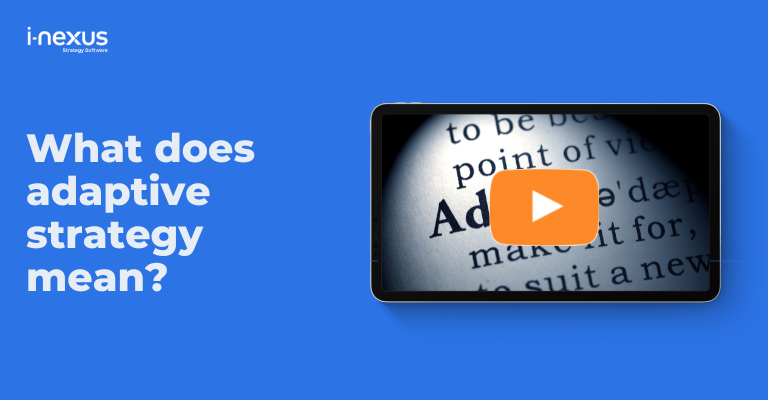From paper exercise to deployment reality - the critical thinking process behind deploying your strategy is crucial to your success. Today we’re examining the five-step critical thinking process to laying out a high-quality, focused, measurable, and realistic annual strategic plan.
Written by: James Milsom, Head of Marketing
Regardless of the Strategy Execution methodology applied, being successful in the modern era of strategic management is through effective planning, implementation, execution and measurement of efforts.
However, between the planning and implementation phase there is a juncture of grave importance – where we define three-five year strategic objectives and segment these into annual breakthroughs.
Doing so is not a simple tick box exercise of rinsing and repeating what you do on a daily basis, perhaps with a slight increment of measurement attached.
Instead, it requires your leaders and supporting stakeholders to think critically.
Going beyond the realm of the possible and into, quite frankly, the unknown to your business can be daunting.
However, it is only through aiming for performance levels out of your existing reach that you can develop improvements, embed those into your daily management, and succeed in Strategy Execution Management.
Today’s overview looks at the critical thinking required to turn your strategy from a paper exercise into a deployed reality, tips on the five steps you must complete to achieve a new level of thinking for your strategy, and the reasons why you’ll conclude that is paramount to your success.
When should you plan?
To begin, we are often asked when you should begin strategic planning.
This is wholly dependent on your business norms, but typically the strategic planning process should start halfway through the calendar year (or your financial year).
Then, after three-four months of planning you can define your level 1 Hoshin (your three-five year plan), and after than level 2.
All in, the process will take half a year.
To learn about the different levels of deployment, be sure to watch our accompanying webinar.
And then, at the end of year you will be well placed to communicate the next year's improvement priorities, the level 1 and 2 plans, and action plans in place to convert these into reality
The following considers developing your annual strategic plan from level 0 – the top level of your organization.
The five steps of annual strategic planning
1) What
What you want to achieve will be set out in your three-five-year strategic plan, which is naturally linked to your business policy and the voice of the customer.
This must then be translated into annual breakthroughs in your second step – bitesize chunks of initiatives to be tackled each year.
2) How Far
The aim at the second step should be to front-end load a set of annual objectives, with the logic being that the majority of the value is to be secured in the first year.
This is because as you move into the second and third years it becomes tougher to achieve the objectives which are set.
The mountain of objectives
Those objectives set in the first year will be foundational in nature, therefore you are, to consider a metaphor, at the start of the mountain.
The opening terrain is less treacherous than say the mid-way point and then the peak. Your strategic plan should aim to navigate half of the mountain of objectives, successfully, in the first year.
The mindset is one where you do not hesitate and push actions to a tomorrow and beyond. The time to act is now.
Naturally, the more success garnered at the beginning of your strategy, commitment and engagement levels will be higher moving into year two and so on.
Processes are embedded and the actions become standardized ways of working for your organization, meaning that you continue to reap the rewards of the first year well into the future.
Your objectives must have a ‘from’ and a ‘to’ involved. Here are some examples:
- We will improve our defect rate on wireless handsets from 3 Sigma to 4.3 Sigma
- We will increase on time deliveries from 92% to 70%
- We will reduce our packaging costs by 25%
- We will grow our market share in wearables from 12.3% to 19%.
Checklist for designing annual breakthrough objectives
Use this 10-item check list to review your annual goals:
- Does it identify how far to improve in the first-year in order to hit the three-five year breakthrough objective?
- Does it divide the three-five-year breakthrough into annual amounts?
- Does it quantify the first-year goal?
- Is it a stretch goal?
- When we accomplish the annual objective, does the customer benefit?
- Will it provide significant competitive advantage?
- Does it require multi-functional involvement?
- Will it result in a new standard and / or system?
- Is the answer to 'how do I do it?' unknown?
- Have you checked that no problems exist in the other areas that need to be fixed first?
It is not enough to simply re-write your existing goals – it must stretch your business beyond its existing levels of performance.
Remember, if it does not do this, or the above answers aren’t yes, this is not an annual objective which supports your strategic plan.
3) How
Now you must switch gears to consider how you can take annual breakthrough goals and convert them into tangible action plans.
Action plans are a crucial step in strategic implementation, involving stakeholders and teams in defining the steps which must be taken to achieve improvement priorities.
Improvement priorities are the drivers you’ve identified which, likely in the form of a process, can create sustainable results.
They are, indeed, not short-term tasks. Instead they are focused on the voice of the customer and their needs.
Fine tuning your thinking
How you identify improvement priorities can be as simple as fine-tuning your critical thinking.
For example, if you were asked to improve sales for the business, that is a vague, if not frustrating task to be set, immediately failing our criteria for the priority to be focused and long-term.
However, if you were asked to identify what process are preventing you from entering what we perceive to be our most valuable new markets, that gives you a focus.
From there you would incorporate techniques such as value stream mapping and the 5 whys to reach your conclusions and form priorities.
But remember, don’t take on too many priorities. A priority is not a priority when everything else is a priority.
Additionally, if you cannot easily communicate and measure the top-level improvement priorities to your business, then you must re-evaluate your priorities.
Through critical thinking you will be in a position where you know, with confidence, what you can do to enable your business to reach its annual breakthrough objectives.
Checklist for defining annual improvement priorities
Use this seven-item check list to review your priorities:
- Does it lead to creation of a sustainable process?
- Does it lead to creation of a result-oriented process?
- Does it meet current, latent or emerging customer needs?
- Is it easy to communicate?
- Does it demonstrate a simple flow of logic?
- Is it measurable, but not a measure itself?
- Does it exceed budget targets?
The end-result must be a clear set of priorities that are targeted for improvement, putting you beyond your existing performance.
If it does not, or fails to exceed your budget targets, this is daily management, not breakthrough activity.
4) How Much
Moving into the how-much category we start to turn our attention to measuring the effectiveness of processes. This relates to target setting.
Improvement priorities will guide you as to how you can achieve breakthrough change. Target will tell you how much you must improve by and by what date.
Targets within a Hoshin context are known as Targets To Improve. Their structure is:
From X
To Y
By 123
The value of target setting
Having identified the processes that are worth improving, a measurement system must be put into place to gauge efficacy, otherwise you will be unclear as to your abilities against set targets.
A sound, working knowledge of statistical control is beneficial here as you can set out and manage expectations of performance based on your previous analysis.
To learn more about statistical control, read our Six Sigma overview.
Examples of Targets To Improve
- We will decrease churn rate from 14.5% to 11% by August
- We will reduce our cost per acquisition from $445 to $380 by September
- We will decrease product defects from 15% by 10% by November
- We will double sales growth in the wearables market from £3.3M to £6.6M by December
In any case, it is highly recommended you measure what matters to your customers, link it to the process and the improvement priority in question.
Checklist for setting Targets To Improve
Use this seven-item check list to set effective targets:
- Does it track progress towards full implementation of the improvement priority?
- Can it be broken down into at least monthly progress increments?
- Does it exceed budget targets?
- Does it track progress towards achieving the annual objectives?
- Does it show when the improvement priority has an impact on the annual objectives?
- Does it measure results, rather than action plan milestones?
- Is it easy to calculate and communicate?
To track your targets it is recommended that you adopt something similar to Hoshin Kanri’s Bowling Chart.
To learn more about the power of the Bowling Chart, click here for our overview.
5) Who
This is absolutely unique to your business, culture and policy.
You must, at this stage, know what resources and people are needed to achieve your annual objectives and improvement priorities.
Ask yourself, who will deliver the results you need, most effectively?
How to know who to involve
In terms of achieving a sense of who should be involved, consider approaching the analysis with this in mind:
- Establish which resources are required on daily management activities (operational / business as usual)
- You are investing in improving a process in one year and the moment after that your process becomes standard value delivery. It is not a project.
- Which resources (human, systems and material) have the greatest influence or opportunity to impact the improvement priority and targets to improve?
- The largest sum or most available resources do not necessarily correlate to having the greatest impact
- These are not necessarily the resources that keep operations running each day, instead they are the talents, thinkers and doers who are best placed to help you realize a step change in performance this year.
- This will, naturally, involve crossing organizational boundaries and challenge existing siloes – be wary of the role of culture here.
Translating this into a systematic view of what resource is needed in which area can be achieved through a planning system such as the Hoshin X-Matrix.

Whether you name this view your policy deployment matrix, strategy matrix or Hoshin X-Matrix, it is a narrative of what your business will achieve, how far they will go, how it will be achieved, how much resource is needed to do this, and who is involved.
From here primary and secondary responsibility will be assigned to leaders (via a dot on the matrix – these people own the objective.
The end result is a total view, whether on a company, site / plant and division level of the deployment strategy and plan.
But be mindful, the further layers you create, the more administration involved, and thus fatigue and disengagement with the strategy.
Is critical thinking important for Strategy Execution Management?
Critical thinking is paramount to your strategy’s success.
Without establishing objectives, prioritizing processes to improve, setting targets (and measuring them), all the while securing the right resources to do this, you may wonder how businesses achieve their strategic goals.
It is with great effort and alarming failure rates.
Challenging your thought processes and your strategy, and more importantly, customers will reap the rewards.
What will your next steps be in Strategy Execution Management?
Click here to visit our strategy execution knowledge hub, filled with content to support you in embracing the 'no normal' of strategy in the 2020s and beyond, or explore these recommendations:
- Strat to Action – Developing a countermeasure culture: Watch our on-demand presentation of how you can guide your business towards using data and countermeasures to drive strategic success.
- How AI and machine-assisted learning will help your Strategy Execution: As Artificial Intelligence becomes a mainstay in our lives, read how AI and machine-assisted learning will evolve to support your Strategy Execution.
- Download our Key to Strategy Execution eBook: Read how companies like Danaher and HP have mastered Strategy Execution Management and what you can learn from them.
About the author
James Milsom is Head of Marketing at i-nexus. James has wide-ranging experience in markets such as telecommunications, energy, education, and software.
As Head of Marketing, his drive is to raise awareness and understanding of the challenges facing enterprises in delivering strategic objectives and transformation amidst changing markets and the obstacles traditional tools and methods present leaders.
If you’d like to talk more about Strategy Execution, reach out to James on james.milsom@i-nexus.com or connect with him on LinkedIn for the latest insights.



